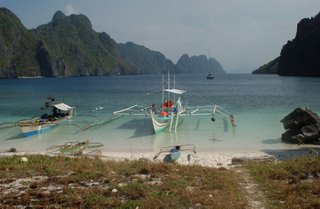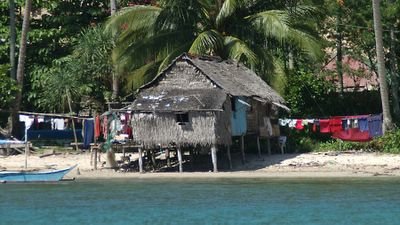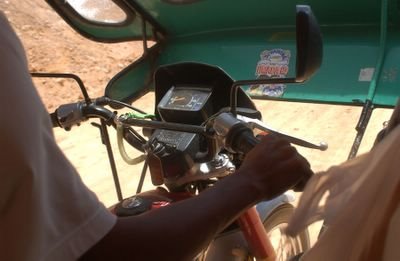MARCH 27, 2006- EL NIDO
 Fjord Country in The Philippines
Fjord Country in The PhilippinesWe arrived in El Nido, on Palawan Island, in the Philippines, ten days ago, and have been visiting in nearby Bacuit Bay, where El Nido is located, since then. The sleepy, wild-west, town of El Nido is mostly a backpacker destination, where people who have heard of it, and have endured a bouncing 8 hour jeepney ride up from Puerto Princesca to get here, gather at the end of the road for a real adventure.
 El Nido
El Nido El Nido
El NidoWe are on an adventure ourselves, touring around the bay on our boat looking for interesting spots to anchor.
CORONG CORONG BAY AND EL NIDO
On the back side of the point where El Nido is located is a bay called Corong Corong Bay. It is scenic and protected, and here you can anchor your boat and catch a tricycle taxi into town for provisions or cold beer, or just sight seeing. There are a few families living at Corong Corong living in thatch houses which extend on stilts over the water. On our way in a man on the beach motions to us to land where he is standing. He introduces himself as Felix, and he asks if we need to have laundry done. We do; (maybe he saw the large bag in our dingy). A woman walks up with a baby in her arms and in articulate English tells us she can do it, by hand, and it is 70 pesos a kilo. She removes a cloth covering a scale on the sand next to the house and we weigh the bag; nine kilos, about $12 for wash dry and fold. We realize this is a well organized routine they go through for any yachties who come ashore. Its OK with us.
 Laundry
LaundryWe go into El Nido and find a pleasant little town with a few stores and tourist establishments, mostly guest houses, bars, and simple restaurants on the beach.
 Inside an El Nido Taxi
Inside an El Nido TaxiWe buy what we need and try email at one of the two places which have signs about Internet. The power is off in town, and the computers aren't working. That night, the power is still off, but most businesses have generators, and we finally get a shot at the internet. It is slow and we accomplish little. It doesn't matter, the dinner was good. The next day, from the boat, we can see our sheets and towels on the line by the womans house.
More El Nido PhotosClick here so see the view od El Nido cliffs out our hatch.
Click here to see an El Nido Traffic Jam, (it's all relative, Isn't it?)
Click here to see an El Nido shopping trip
Click here for Judy's self portrait
Click here to see a local shop
Click here to see a loaded Jeepney. Would you wish to ride this for eight hours?
Click here to see a man and his dog
A man stops by in a dingy. It is Benoit, a friend from Hong Kong, and his cat Atmosphere is anchored behind the next point. He tells us that there are much better places around Bacuit Bay that we should try to visit.
We decide to go on a tour. We collect our laundry and it is marvelously clean and smells fresh. We load what provisions we can get in El Nido, and we are ready. We like El Nido and Corong Corong Bay, but it is time to look around. We weigh anchor.
BACUIT BAY
 Split Rock
Split RockBacuit Bay covers about 80 square miles and it is dotted with high, shear sided islands. They rise vertically from the sea, and look like sentinels. When you are close to them they stand far over your head. The sea around them is deep and clear.
The first days we just motor all over Bacuit Bay looking at the amazing scenery: blue waters, white sand beaches, and tall, tall, rugged islands. It is stunning. Judy on The Sand
Judy on The Sand Banca & Swimmers
Banca & Swimmers
More Bacuit Bay photos:
Click here to see a gorgous beach.
Click here see Judy walking on white sand.
Click here for a Bacuit Bay Scene
BOX CANYON AT LAGAN ISLAND
 Banca & Swimmers
Banca & SwimmersOne of our first stops is Lagan Island.
After dinner we go on deck to watch the stars come out. We at Lagan isl;and in the center of what feels like a box canyon, surrounded by high cliffs which leave only a portion of the sky visible in which to watch for stars. Frogs or birds or some other night time creatures fill the air with their sounds, and the cool breeze wafts over us coming down from the hills above. We are anchored in the center of a small cove on, but it feels like somewhere high up in the mountains..
We watch the few stars that we can see, and try to pick out constellations.
The cove is still, and the night dark.
More Lagan Island photos:
Click here to see our achorage at Lagan Island
Click here for a sunset shot
Click here to see the cliffs at night
CATHEDRAL CAVE
A couple of cryptic notes in our guide books mention a Cathedral Cave on Pinsail Island, supposedly good for a visit. We are not sure which island is Pinsail Island, the chart is vague on that point, or what Cathedral Cave is, but we decide to try to find out, We set off in the dingy towards a a group of small islands. One must be Pinsail. The likely candidate looks like a giant ice cream cone and when we circle around behind it a opening appears in the limestone wall. The opening is ten feet wide and thirty feet high, and there is deep water going right inside. This must be Cathedral Cave. We motor in. A cave opens up, the ceiling is well over 100 feet above us. Limestone columns line the walls like pillars in a church. Far above our heads is a bit of daylight coming in though a hole somewhere around a corner. The waterway inside ends after a few yards and the floor is large boulders, but the cave goes on. It splits in two and continues out of sight into the darkness. We look in awe at this cave for a few minutes, then we depart and head back toward Wings.
 Cathedral Cave
Cathedral Cave  Looking Out from Cathedral Cave
Looking Out from Cathedral Cave
TAPUITAN FJORD
 Fishcanp and Bancas
Fishcanp and BancasIt is hard to find words that adequately describe the narrow Tapiutan Straits between Maniloc Island and Tapuitan Island. Think of it as a fjord. It is a narrow, twisting, body of deep water between the two high ridge-like islands. The islands are sided by vertical cliffs of dark gray limestone topped everywhere by weathered jagged, razor like points of rock, and crisscrossed by diagonal cracks and crevasses. On top of every peak and in every crack and crevasse are green tropical plants and small bushes.
The water is flat, protected from most of the winds by the curves of the strait. The sun beats down on the limestone and foliage and the blue sea sparkles with tiny waves. Light green shallows lie along the edge of shoreline, where the coral grows, and sand under the surface glows with a luminescence. The coral ends abruptly a few yards from shore and the bottom drops suddenly to depths of a hundred feet or more. Spaced unevenly along the foot of the grey walls are small sandy beaches, blindingly white with pure, fine, powdery sand. The beaches are inviting and during the heat of the day we visit a few and swim in the cool water.
The fjord is quiet
What sounds there are, like a banca engine or the voice of a fisherman, echo across the water, but mostly we hear only the sounds of schools of tiny fish leaping from the water, chased by lean predators. Both prey and predator splash back in unison and then repeat the process half a second later, and then again, through the long hot day in the still fjord.
Such is the beauty of this place that we anchor here even though we cannot find any depth less than 90ft. We run out 200 feet of chain and then listen to it rumble across the rocks down there, but in the still fjord there is little wind to make the anchor drag, only gusts and puffs which come down from the hills at night to make us nervous. We take down the awning each night, more to reduce the noise of it flapping than because of the wind strength; and we set it again each morning to give us much needed shade.
Snorkeling along a sandy patch on the far shore and we encounter a large school of small silver fish, so many that they look like an opaque silver cloud in the water. We swim among them as they pass us endlessly around a large oval, and bigger fish lurk on the periphery. We see a large barracuda motionless nearby; then it slowly moves off. A ray flaps by.
We stay in Tapuitan Fjord for four days.
THREE CAMPS OF FISHERMEN.
There are three camps of Filipinos staying near us in the fjord.
One group lives in a collection of houses on a 100 ft section of sandy beach under a massive wall of limestone which overhangs them 1000 feet up. There are a handful of Bancas pulled up on the sand. This camp has families and looks more or less permanent, with women and babies among the shelters, and men working on the boats and nets. At night there are lights here and we can sometimes hear the sound of a radio news broadcast. We visit in the dingy and the people smile at us as we approach but they are shy and no one invites us to land. We can see that their shelters are small in scale, mere bamboo framed sleeping platforms with roofs and walls of woven palm leaves, but they look cozy and are fastidiously clean.
Another camp is on a point of the island near us. An old concrete house stands there, occupied by someone else and the band of fishermen are staying in the open on the beach nearby, sleeping exposed, and hanging wet clothes on the rocks to dry. They have several small bancas, without engines, and one bigger banca with a motor, and they pile into that one every few days and go away for several hours. The men paddle out in the small ones every morning at dawn, returning before the heat of the day, and go out again in the evening. We don�t know if they catch anything. During the mid day heat they huddle under the the awning of their large banca, tied to shore. We land our dingy at this beach and walk around. The men of this camp look sunburned, dirty, and ill kept. There are no women here. We see large fishing lures shaped like octopi and spot a few dried octopi stretched on a piece of netting; that must be what they are after.
The third camp consists of three men living in a cave behind the tiniest patch of sand, and they have one small banca. We wonder what endeavor keeps them here. We see them motor up to the shear rock wall and two men disembark from the banca and disappear among the limestone crevasses. The third then cruises around the fjord all day dragging a fishing lure. Where have the two others gone; we can't see them? What are they doing?
Then, late in the day, when the sun has already gone behind the ridge, we see one man climbing down the cliff. His bright yellow shorts make him visible against the dark limestone. Judy puts the binoculars on him and expresses amazement that he is coming down the rock wall, among the razor limestone points, with a small pack on his back, in shorts, tee-shirt, and flip flops,Click to see the Man in Yellow Shorts. She watches him stop, precariously balanced on a ledge, and he takes off an apparently damaged flipflop and attempts to put it back together, then proceeds again. He stops every dozen or so yards to repair his shredded flipflop.
I realize that the two men have gone up the cliff searching for bird nests, coveted in other parts of Asia for birdnest soup. The bird's nests might bring a nice price, but apparently not enough to buy climbing shoes.
When the man in yellow shorts reaches the water's edge he whistles and the banca driver comes back to retrieve him. I wonder where the third one is? Later, just as night falls, he appears at the bottom of the cliff in another spot, and he too is retrieved. Motoring back to the campsite the three inspect each other's catch and the man in the yellow shorts studies the bottom of his feet.
The next day they are gone, their cave empty.
More Tapuitan Strait Photos
Click here and here and here and
here and here to see more of Tapuitan Strait
GUNTAO ISLANDS
This is our last stop on the El Nido cruise. The Guntao Islands are a bit more wild, and a bit more remote then the rest of the islands in Bacuit Bay. They are far out to the west, exposed to the South China Sea. We tuck into a bay in the west side, protected from the east winds, where there is a sandy patch for our anchor The wind and waves pass around us, leaving us a small bit of quiet water. We anchor here and wonder if the peace will last. We go to the beach but a low swell which comes into the bay, one which we didn't notice from the boat, and turns the shoreline into a surfing beach. We try to go ashore anyhow but the dingy wheels get stuck in the soft sand on the steep beach. We struggle to pull the boat up. Then we find the sand so soft it is difficult to walk; so much for the exercise.
We go back to Wings, tie off the dingy, and swim ashore to do some snorkeling. The water is clear and there are quite a number of fish, some big ones. Later I scrape barnacles off the propeller and keel of Wings. I don't know when or if I'll get a chance to do it again.
Before dinner we watch the sun set in the west, the first sunset we've seen in an anchorage since Borocay in Febuary. We've been inside island groups with no view of the ocean to the west. Here, the view is clear, the horizon is unobstructed.
Tomorrow we set sail for South Palawan, to check out of the Philippines. We figure it is five days of short hops down the coast.
We hope for wind.
Fred & Judy, SV Wings, Palawan
----------
radio email processed by SailMail
for information see: http://www.sailmail.com
Labels: Philippines

.jpg)

0 Comments:
Post a Comment
<< Home